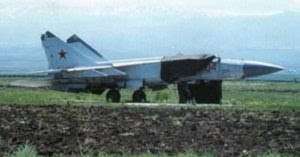The Secret of Azeri MiG-25 Hijacked by Armenians in 1993

In the chaotic months of early 1993, when the First Artsakh War was raging at full intensity, an extraordinary operation unfolded far from the frontlines – one that remained hidden from the public for decades.
According to later disclosures, Armenian intelligence carried out a covert mission that led to the hijacking of an Azerbaijani MiG-25 fighter jet, one of the most advanced aircraft in the region at the time. What the public was told back then was completely different: a story of a MiG being shot down near Krasnoselsk after it had allegedly violated Armenian airspace.
Behind that official version, however, was one of the boldest and most secret intelligence operations of the war.

A Confidential Briefing
In late January or early February 1993, a small group of war correspondents were invited to an off-the-record meeting with Ashot Manucharyan, who was then serving as a security adviser. They were warned in advance not to bring cameras and to expect a confidential discussion.
Manucharyan, known for his modest appearance and direct manner, spoke without ceremony:
“Yesterday, our special services successfully completed a complex operation. Under the guise of a combat flight from the Dallyar airbase in Azerbaijan, a MiG-25 took off and landed safely at Erebuni airfield. This jet can perform reconnaissance missions, deliver bombs. The operation was long in preparation. In Russia, we found a former pilot who agreed, for payment, to work with us. His mission was simple: join the Azerbaijani Air Force and, during his first sortie, fly the aircraft to Armenia. That’s what happened.”
Then came the instruction for the journalists:
“Officially, you must report that the Azerbaijani MiG-25 was shot down by our air defense units near Krasnoselsk and crashed into Lake Sevan. Locals witnessed it. The pilot didn’t eject. This version must be the one the public hears – in the interest of national security.”
When asked where the pilot actually was, Manucharyan replied:
“He’s been moved abroad. No one should ever know his real name or location.”
That evening, news agencies published the “official” story. The next morning’s newspapers hailed it as another air-defense victory.
A Quiet Disappearance
A few days later, an opposition newspaper printed a brief note hinting at “a successful hijacking operation.” The authorities dismissed it as “press nonsense.” The story vanished – absorbed by the endless flow of war news.
But for those who were there, the event remained unforgettable: a rare glimpse into the unseen side of the First Artsakh War, where psychological warfare and secrecy were as important as the battles themselves.





